(单词翻译:单击)
Everyone has their own favorite foods to choose from, but how many of our beloved foods do we know the history of? Who has sat down with their burger at a fast food chain and asked themselves 'Where did the idea of burgers come from?' Probably nobody, as their mouth would be full of burger before the thought would even occur to them. Some of the foods we eat day-in, day-out, however, can have surprisingly long histories behind them. In this list, we'll be exploring the origin stories behind ten commonplace foods from around the world. Try not to get too hungry.
每个人都有自己喜爱的食物,但我们对它的历史了解多少呢?谁会在快餐店里拿着汉堡坐下,然后问自己:"汉堡的主意来自哪里呢?"可能不会有人这么做,因为在他们这么想之前,嘴巴就已经被汉堡塞满了。然而,我们每天所吃的食物背后可能存在着令人吃惊的悠久历史。在这篇文章里,我们将了解全球常见的10种食物背后的故事。可不要太饿哦。
10.Burgers
10.汉堡包
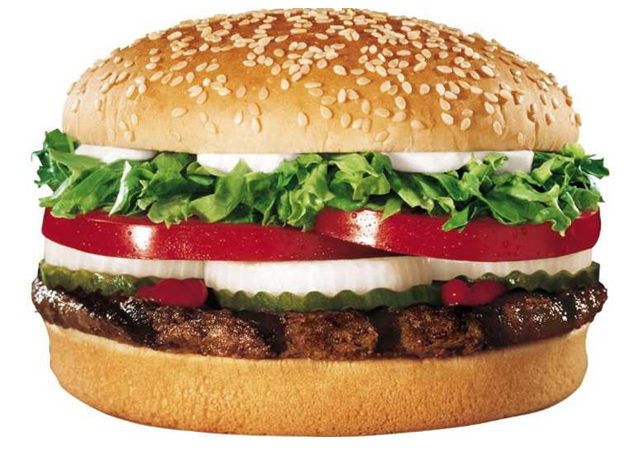
A lot of people reckon that the burger was an American invention, but they were by no means the first country to think it up. The humble burger, like many other foods, actually has quite a long history attached to it. Perhaps it did not have cheese, onions, and buns to go with it, but it was definitely there.
很多人认为汉堡包是美国人的发明,但他们绝不是第一个想出这个点子的国家。像其他很多食物一样,平凡的汉堡包实际上有着非常悠久的历史。或许那时它还没有加奶酪、洋葱和小圆面包,但它确实已经出现在那里。
The full name, 'hamburger', originates from 1880, when German immigrants created the meal within Hamburg, Germany. In order to make a beef steak, they would grind up the meat and create a steak from what remained, calling it a 'Hamburg steak'. This steak would eventually have its name shortened to 'hamburger'. What must be noted, however, was that this was the origin of the steak itself – nobody quite knows where the idea of sticking a hamburger between two buns came from. As for the steak itself, we have our German friends to thank for that. Big Macs would not be the same without you. There is a little bit of history that states that the Romans created the 'Isicia Omentata', regarded as the first burger. However, this appears to be a recipe for a sausage, rather than an actual burger. More on sausages later.
它的全名是"汉堡包",起源于1880年,当时德国移民在汉堡发明了这种食物。为了做牛排,他们将肉磨碎,用它制成肉饼,叫做"汉堡牛排"。这种牛肉饼的名字最后缩短成了"汉堡包"。但必须说明的是,这是牛排自身的起源——没人知道把一个煎牛肉饼贴在两个圆面包之间的主意从哪儿来。至于牛排,我们要感谢德国朋友。要是没有你们,现在的巨无霸也会不一样。有一些历史表明罗马人发明了"Isicia Omentata",这被认为是第一款汉堡包。但是,它的制作食谱看起来像是一个香肠的食谱,而非真正的汉堡。后面会介绍更多关于香肠的内容。
9.French Fries
9.炸薯条
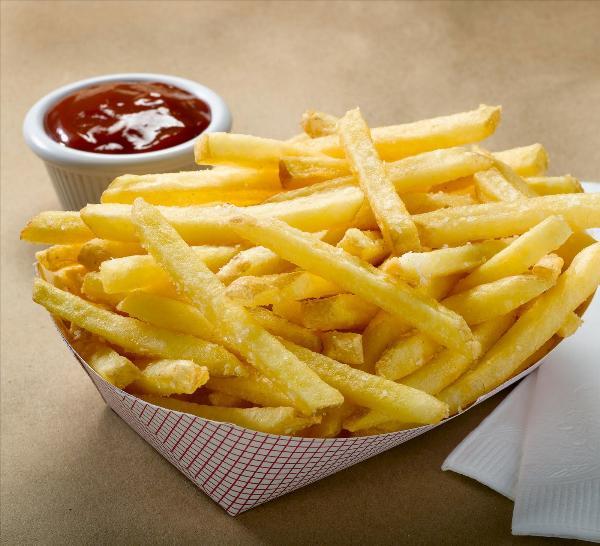
Of all the foods to have an origin story, this one seems to be the most clear cut as to where it came from. Unfortunately, there's an ongoing dispute between France and Belgium as to who really made it.
在所有具有历史起源的食物中,这一款食物的源起最清楚不过。不幸地是,法国与比利时一直在争论到底是谁真正发明了这种食物。
The Belgian side of the story is that the 17th Century residents of the Meuse Valley in Belgium were not shy of frying things. They had a tendency to fry any fish that they caught, which made up the majority of what they ate. When winter came and the rivers froze over, the Belgians turned to the ever-reliable spud, preparing them in battered slices, the same way they prepared fish. The French side states that, in the late 17th Century, potatoes were regarded unfit for human consumption, and only for pigs to eat. When a famine struck in 1785, this mind-set changed, and the French gave the potato another chance. It caught on so well, by 1795 they were grown everywhere, with even some royal gardens being converted to help grow the friendly spud. During this boom, someone had the smart idea of frying the slices and selling them as 'frites'. Thus, the French fry was born. Whichever side you take, just remember that asking for 'Belgian fries' at a drive-thru will get you funny looks.
比利时的版本是:17世纪比利时默兹河流域的居民喜欢吃油炸食品。他们习惯把捕来的所有鱼都进行油炸,这在他们的饮食中占据了绝大部分。当冬天来临,河流冰冻,比利时人就求助于他们一直以来所依赖的马铃薯,把它们切成薄片预备着,他们对鱼也采取同样的处理方式。法国的版本是:在17世纪后期,人们认为土豆并不适合食用,只能用来喂猪。到1785年爆发了饥荒,这种想法才得以改变,法国人发现了土豆的另一个用途。它变得相当流行,到1795年已经在各个地方都有种植,甚至一些皇家公园都被改造以有利于这些友好的马铃薯生长。在这个土豆繁荣的时期,有人想出一个聪明的点子,将土豆切片并油炸,然后起名为"炸薯条"进行售卖。薯条由此诞生。不论你相信哪个版本,只要记住,在汽车餐厅里点一份"比利时薯条"会让你看起来很搞笑。
8.Sausages
8.香肠
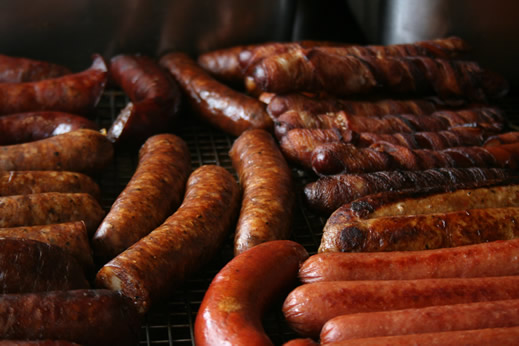
The exact origin of the sausage is unclear, with reports ranging around 50,000BC. There is an agreement, however, that the sausages, frankfurters, and hot dogs that people eat on a daily basis originated from a desire to preserve meat.
香肠的准确起源并不清楚,大约在公元前50000年就已经有了相关记载。不过存在着一个共识,那就是人们每天吃的香肠、法兰克福香肠和热狗都是源于人们保存肉类的愿望。
Ever wonder why sausages are wrapped in some form of casing? The reason is that, before refrigeration, butchers would want to preserve meat during transit. They took the meat, organs, and blood of a slaughtered animal, sprinkled it with salt to preserve it, then wrapped the gristly results in the animal's intestine or stomach to stop it going off before it could be eaten. This is why some sausages contain a large amount of blood in their recipes; the origin of this practice was to help use up any blood that was left over after slaughtering an animal. We have no real use for salting today, given how good fridges can be with preserving meat. The tradition of meat in casing, however, still goes strong to this day.
想知道香肠为什么要用各种肠衣包裹?原因就是在冷藏之前,屠夫想要在运输途中保存肉类。他们将动物屠杀,在所得的肉、五脏和血上撒盐以便保存,然后将这些柔软的东西包进动物的肠或胃里,防止吃之前腐坏。这就是为什么有些香肠的制作食谱中包含有大量的血,这种做法是为了用尽屠杀动物后所留下的所有血。在今天,我们已经无需再盐腌肉类,因为有冰箱可以保存肉类。但是,将肉灌进肠衣的传统至今仍然盛行。
7.Pizza
7.披萨
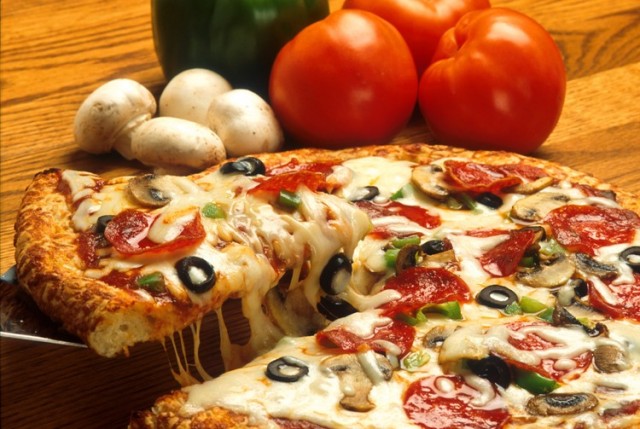
Any time anyone mentions the dish, the image of black-haired, rotund Italian chefs kissing their fingers comes to mind. The 'traditional' image of the dish consisting of bread, tomatoes and cheese did, in fact, originate from Naples. The food was easy to make with little cost, and was regarded as something that the poor could eat to keep themselves going. It contained cheese, tomatoes and basil – very similar to the kind we consume today. The idea of placing food on top of flatbread, however, dates before the Italian invention.
任何时候想起这个食物,人们脑海中就会浮现出黑头发圆滚滚的意大利厨师亲吻自己手指的画面。这款食物包含着面包、土豆和奶酪的"传统"形象实际上起源于那不勒斯。这种食物容易制作,成本低,被认为是穷人也能吃得起的东西。它包括奶酪、土豆和罗勒——与我们今天食用的很相似。但是,将食物铺在面饼上的主意最早由意大利人发明。
A lot of cultures – including the Romans and the Egyptians – came up with the concept of meal on top of flatbread, but the Persians were the first recorded case. When King Darius the Great ruled the Persian Empire, it is thought that his soldiers baked flatbreads on their shields, and added cheese and dates for flavouring. Ordering Dominos while in enemy territory just isn't ideal.
很多文化——包括罗马与埃及——都给这种面饼上面的食物下过定义,但波斯人最先进行了记录。在大流士一世统治波斯帝国的时候,他的士兵就在盾牌上烤制面饼,并添加上奶酪和枣椰子调味。在敌人领地里要求吃上达美乐披萨可不太现实。
6.Tomato Ketchup
6.番茄酱
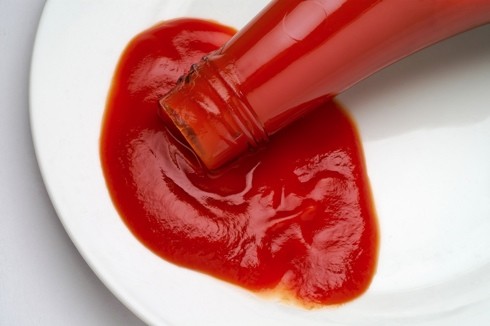
Everyone would probably think that tomato ketchup would originate from the US, and they'd be right. The first recipe popped up in 1801 in the 'Sugar House Book', an American publication. What's interesting about our favourite condiment, however, is that ketchup was based on an older recipe.
人人都会以为番茄酱起源于美国,他们没错。第一份制作食谱于1801年出现在《糖屋书》中,这本书由美国出版。但是,有趣的是,这款我们最喜欢的调味品其实是在一份更加古老的食谱基础之上制作而成。
Its original name is 'ke-tsiap' and it started in 17th Century China. While it has a name similar to the bottle of red stuff we shamelessly apply to everything, the actual sauce itself was made up of fish brine and spices. The Dutch and English would end up taking a few bottles back home with them, well-loved due to its ability to keep for large amounts of time, a key trait that sailors and travelers appreciated when stocking their larders. The sauce saw a lot of remixes on the original recipe – including a moment in time where mushrooms where a primary ingredient — before the tomato variation was devised.
它起初的名字是"ke-tsiap",起源于17世纪的中国。尽管它的名字很像我们往各种食物上洒的红色调料,但实际的调味汁本身却是由鱼露和香料制成。荷兰人和英国人最后就带了几瓶回家,这种酱汁得到厚爱,因为它能够保存很长时间,水手和旅行者很喜欢将其储存在食品室里。在最初的食谱中,这种酱汁由很多种材料混合而成——最早的原料中还曾一度包含了蘑菇——后来才发明出了以番茄为原料的变种。
翻译:赵倩 来源:前十网


